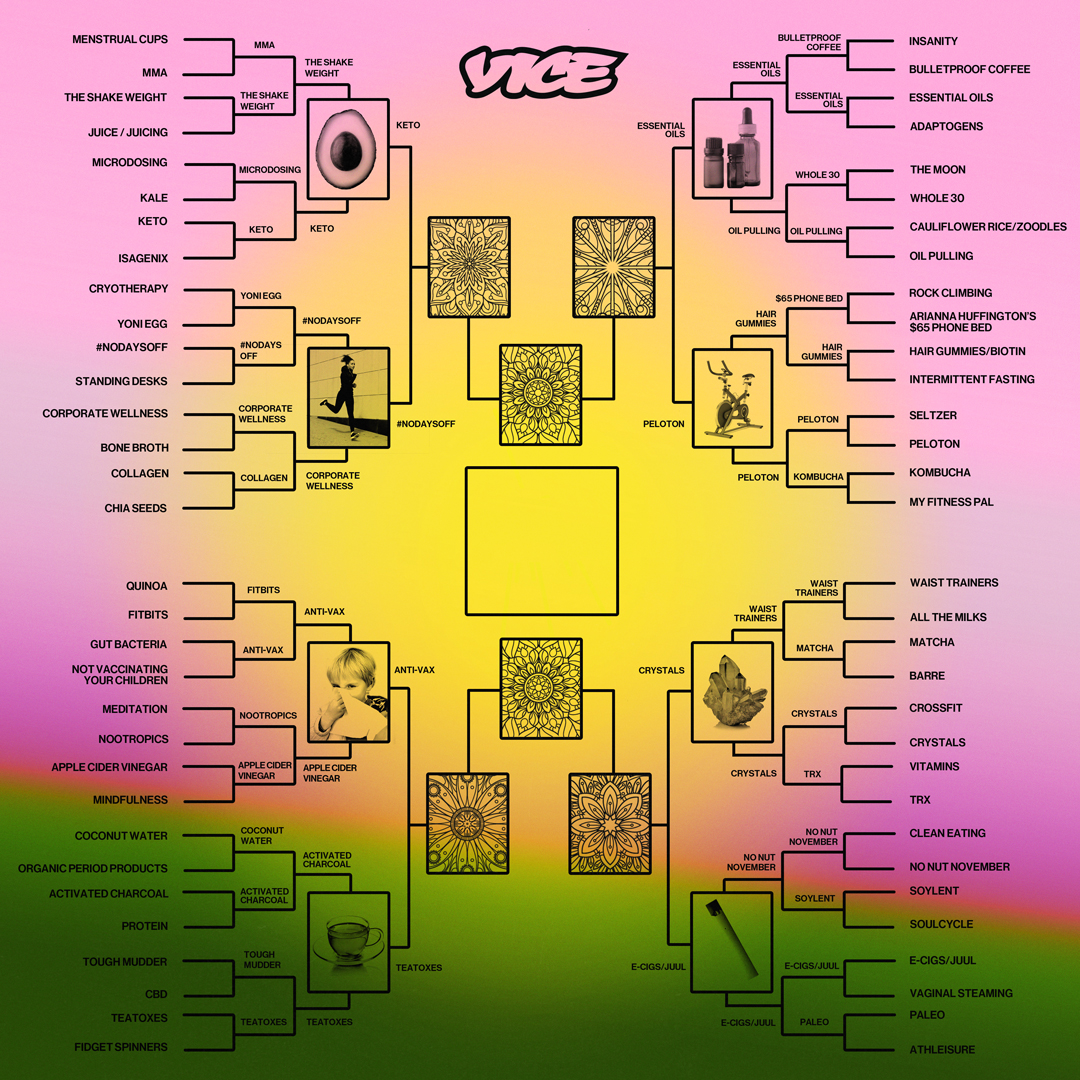It’s the final day of the Worst Wellness Trend of the 2010s Tournament! We’ve made it through Round 2 and Round 3, and lost some good (and by “good,” we mean “bad”) challengers along the way. See you later, hair gummies! Shake Weight, you really gave it your all! The competition is getting tighter, and it’s really anyone’s game at this point.

Today will be a series of quick lightning rounds as we move through the quarter-finals, semi-finals, and finals via Twitter polls. Check this post throughout the day Friday to see the latest updates.
First up: the quarter-finals! Slam some Soylent to fuel up, and then get to voting.
Matchup 1
Keto—Keto, or the “ketogenic diet,” is a high-fat, low-carb meal plan designed to send the body into a state called “ketosis” and burn up stored fat; it spiked in popularity around 2017. Studies have shown it has benefits for people looking to control neurological disorders like epilepsy. Otherwise, it’s potentially bad for your brain because it deprives it of the glucose it needs to run smoothly. Plus, it’s notoriously hard to sustain. Have you ever gone out to eat while doing keto? It’s almost as bad as going out to eat with someone who’s doing keto.
#nodaysoff—Because of our deep aversion to loving ourselves, we closed the decade bragging about #grinding, #nevernotworking, and taking #nodaysoff from our jobs on social media. Come on, bb, let’s get that bread and that engagement! It’s not like the labor movement of the late 19th and early 20th century worked tirelessly to get us weekends, paid time off, the 40-hour week, and other necessary reprieves from capitalism’s clutches or anything!
Matchup 2
Not vaccinating your children—Being anti-vax is extremely stupid and actively harmful, and is the rare value shared by extremely wealthy liberals and Republicans. People who neglect to vaccinate their kids mostly do so because they’re worried about disproven side effects like autism. Vaccines are so soundly safe and medically advisable, that not believing in them is like thinking chemtrails are what happen when angels fart.
Teatoxes—In the early 2010s, there was an explosion of “fit teas” with names like Bootea, Skinny Me Tea, and Flat Tummy Tea. Despite seeming to come out of nowhere, the brands apparently had big enough #sponcon budgets to get into the hands of influencers and A-list celebrities who shamelessly promoted them on Instagram. The teas promised to help you “feel light” or “fight bloat”... thanks to the help of senna, an FDA-approved ingredient that is essentially a laxative. In reality, they either did nothing or made you shit your brains out.
Matchup 3
Essential oils— Scented, plant-derived oils surged in popularity around 2017, in part thanks to wellness conspiracists like InfoWars' Alex Jones and Goop's Gwyneth Paltrow, who marketed their purported health benefits to their followers. Multi-level marketing companies like doTerra and Young Living also popped on Facebook, where distributors push them to their friends, claiming they can cure… just about anything a person might like for them to. Medical science points out that they're possibly good for aromatherapy—but that you might want to also try actual medicine for what ails you instead of what amounts to homeopathic perfume.
Peloton—A Peloton is a $2,200+ exercise bike with a screen attached that allows riders to stream Peloton workout classes ($39/month), from the comfort of their beautifully sparse Black Mirror-esque homes. The brand—which is beloved by celebrities like Hugh Jackman and other unknown Rich People—was founded in 2012 and has been “ selling happiness” (again, for $2,245 + $39/month) ever since. If you are looking for a vaguely culty bougie fitness trend to get into, but can’t afford to buy a Peloton for yourself, there’s always the possibility that Hubby will gift you one.
Matchup 4
Crystals—Crystals are gorgeous rocks that believers say harness energy, which can then be used to heal, to attract, and to manifest (or, at least, look nice on a table). The trend apparently sprang out of an uptick in interest in quartz jewelry around 2007, and gained traction throughout the decade. We’re still in the thick of it, even though crystal mining is deeply unethicaland environmentally unsound. At least it’s also proven pseudoscience!
e-cigs/juul—The rapid glow-up (and even-more-rapid fall) of e-cigs and vapes was pretty incredible. At the beginning of the decade, e-cigs were cumbersome contraptions that earned their users a fair amount of bullying; cut to 2018, and everyone (including teens) could be found sucking on their JUULs. The decade comes to a close with vaping’s safety in serious question.
What Was the Worst Wellness Trend of the 2010s?
Round 2: What Was the Worst Wellness Trend of the 2010s?
Round 3: What Was the Worst Wellness Trend of the 2010s?
Sign up for our newsletter to get the best of VICE delivered to your inbox daily.
from VICE https://ift.tt/2Mcq9dJ
via cheap web hosting
No comments:
Post a Comment